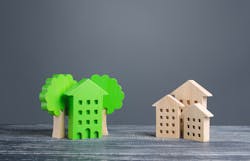A move by the Biden administration to start the long process of electrifying federal buildings could be a watershed moment in the drive to reduce the carbon footprint of a top source of greenhouse gas emissions.
The U.S. Department of Energy announced Dec. 7 that a new rule is in the works that would lead to fully decarbonized, net zero-emissions federal buildings by 2045. The rule would start having impact by 2025, when a move would begin to reduce building emissions tied to energy consumption to 90% below 2003 levels. In 2030, full decarbonization of new and extensively renovated federal buildings would be mandated.
Along with proposing a new rule, which will be subject to comment and extensive formulation, the administration announced the creation of a first-ever performance standard for federal buildings. Fashioned by the administration’s Council on Environmental Quality’s (CEQ), it requires agencies to cut energy use and electrify equipment/appliances to hit a zero-emissions target in 30% of their buildings by square footage by 2030. Agencies would purchase American-made products such as heat pumps, electric water heaters, and other energy efficiency and building system technologies supported by the Inflation Reduction Act.
Both moves are potentially significant because a broad push is underway nationally to address energy usage and carbon emissions in buildings, which by some estimates account for three-quarters of United States electricity usage and require 40% of all primary energy generated to power their operations. With the federal government’s massive building stock, a plan to address energy usage and emissions in those facilities could contribute mightily to that effort.
In the view of New Buildings Institute, the Portland, Ore., group that’s a leading advocate for green, energy-efficient buildings, the federal government’s move could be consequential. Alexi Miller, NBI acting director of building innovation, tells EC&M that it could be transformative from the perspective of sending signals that will be read by businesses, market participants and policymakers.
Noting that the General Services Administration owns or leases some 375 million square feet in nearly 10,000 buildings, Miller says the impact of a plan to transform how that property utilizes energy can’t be overstated.
“The beneficial impacts of these policies are huge and the market-building impacts of having the federal government focus on these solutions are massive,” he says.
From directly reducing greenhouse gas emissions from a massive collection of buildings and setting an example that the private sector and state and local governments can follow, to demonstrating that technology is market-ready and showing suppliers that a market exists, the proposed rule and standard could deliver both tangible and symbolic results, Miller says.
“We hope this is a first step toward a fully decarbonized government building stock and a demonstration of what’s possible in buildings everywhere,” he says.
While rule formulation will be a long process, Miller says the announcement itself is significant. A formal declaration of intent sets the stage for a debate of the particulars and will lead to a steady adoption of new policies and procedures for constructing and renovating government buildings. “It’s the implementation that will be hard to reverse,” he says. “Given the reasonableness of the commitments made and recent precedents on action (federal funding and “buy clean” rules) we don’t anticipate much movement from what is here (proposed) to the final version.”
Ahead of the set of proposed mandates, the government has been moving to transition facilities to use less energy and reduce greenhouse gas emissions. In a statement announcing the proposed standard, the government notes examples of “greener” courthouses, government office buildings and laboratories.
“Federal agencies are advancing net-zero goals across new building construction, major modernizations, and existing building retrofits—electrifying systems, saving energy, and lowering emissions,” the statement notes.
They include a new federal courthouse in Des Moines, Denver Federal Center Building 48 and facilities operated by National Renewable Energy Laboratories and Pacific Northwest National Laboratory.
Tom Zind is a freelance writer based in Lees Summit, Mo. He can be reached at [email protected].
About the Author
Tom Zind
Freelance Writer
Zind is a freelance writer based in Lee’s Summit, Mo. He can be reached at [email protected].
